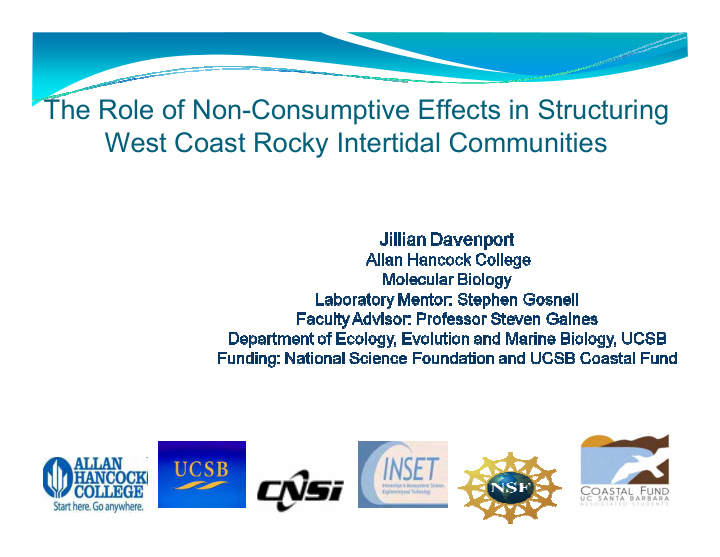



The Role of Non-Consumptive Effects in Structuring West Coast Rocky Intertidal Communities
Importance of Research Objectives � Ecology has often focused on the importance of predators to community regulation ( Paine 1969 ) � most work focused on consumptive effects � Recent studies have suggested non-consumptive effects may be as important ( Preisser 2005 ) � Also suggested that temperature may impact predator consumption ( Sanford 1999 ), but relationship to non-consumptive effects unknown � Understanding total predator impact and potential influence of climate on communities requires evaluating all predator effects � Goal: Determine total impacts of predators (consumptive and non consumptive effects) and interaction with temperature � draw conclusion regarding impact of climate change on west coast intertidal communities
Basic Understanding of the System � What species and why? � Critical to intertidal food chain Pisaster ochraceus , ochre sea stars; keystone predator Nucella emarginata, sea snails Mytilus californianus , mussels; foundational competitive dominator Courtesy: google.com
My Research Focus � What ARE “non-consumptive effects?” � Effects predator has on another organism other than strictly consumptive effects (consuming=death); effects of predator simply due to presence � Goal: Determine non-consumptive effects of Pisaster ochraceus (Sea stars) on Nucella e marginata (Sea snails) in “normal” ocean temperature(12 degrees Celsius/54 degrees Fahrenheit)
Experimental Methods � Collection of species: � Mytilus californianus (MUSSELS)-collected @ Campus Point different class sizes (0-15, 15-30, 30-45, 45-60 mm) to mimic natural variation � � Pisaster ochraceus (SEA STARS)- collected @ Jalama, Carpenteria, & Campus Point � Nucella emarginata (SEA SNAILS)-collected @ Campus Point � Experimental design: � Prey (Mussels), 20 of each class size placed in 48 ounce non-toxic plastic containers with holes to allow circulation and water � Predators marked and measured prior to experiment and randomly assigned to treatments( 6 sea snails and 1-2 sea stars)
Experimental Treatments * A) B) C) D) 3 3 3 3 NO Sea stars 1 Sea star NO Sea stars 2 Sea Stars Mussels & Sea snails Mussels & Sea snails Mussels & Sea snails Mussels * “control” group
3mm Measurements
Statistical Analysis � Snail growth & shape : The Analysis of Variance (ANOVA) � used to evaluate impact of treatments on continuous variables( i.e.: 1.2543, 4.5678) � statistical technique used to predict how many times by chance (randomly) particular measured averaged values will be the same and come to pass � Snail behavior & feeding : Binary PermutationTest � used to evaluate impact of treatments on discrete variables( i.e: 1,2,3) � statistical technique used to predict how many times by chance (randomly) particular measured averaged values will be the same and come to pass � Scientific numerical significance (generally): p value ≤ .05 = hypothesis is supported � p value > .05 = hypothesis is not supported �
Results � Snail behavior: � Treatment has a significant effect on snail position ( p=.01741,100,000 iterations) Implies at least 1 treatment is different than others � � Post hoc tests Bonferroni method: examines all different combinations of treatments (have 3) � � Significant p-value is: . 05/3(# of tests)=.0167 B) D) C) NO Sea stars 1 Sea star 2 Sea stars p=.00995 p=.00995 Mussels & Sea snails Mussels & Sea sna ils Mussels & Sea sna ils p=1.0
Future Work
Summary � Different field, live organisms main focus- cannot manipulate to yield results � Hands on experience doing various types of field work/collecting data � sea stars, sea snails and mussels collecting � surf grass community surveys � Hands on experience with aquariums � Hands on experience soldering and producing circuit sensors
Acknowledgements *THANK YOU…. *Mr. Stephen Gosnell Prof. Steven Gaines The Gaines Research Lab Group Parternship for the Interdisciplinary Studies of Coastal Ocean California Nano Systems Institute Internships in Nanosystems,Science,Engineering and Technology UCSB Coastal Fund National Science Foundation Mrs. Irene Wong Allan Hancock College
Recommend
More recommend